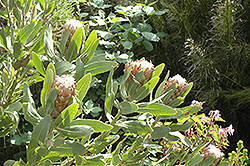It's all about ...
plants

Height: 12 feet
Spread: 12 feet
Sunlight:
![]()
Hardiness Zone: 8b
Description:
These shrubs are known for their large, long blooming, thistle shaped flowers; beautiful pink tones on petals with creamy centers; plant in full sun with plenty of drainage; younger plant not as tolerant of cold; leaves give a sulferous odor when bruised
Ornamental Features
Stinkleaf Sugarbush features bold pink cup-shaped flowers with creamy white eyes at the ends of the branches from mid spring to mid summer. It has attractive olive green evergreen foliage which emerges green in spring. The serrated narrow leaves are highly ornamental and remain olive green throughout the winter.
Landscape Attributes
Stinkleaf Sugarbush is a multi-stemmed evergreen shrub with an upright spreading habit of growth. Its relatively coarse texture can be used to stand it apart from other landscape plants with finer foliage.
This is a relatively low maintenance shrub, and should only be pruned after flowering to avoid removing any of the current season's flowers. It has no significant negative characteristics.
Stinkleaf Sugarbush is recommended for the following landscape applications;
- Accent
- Mass Planting
- General Garden Use
Planting & Growing
Stinkleaf Sugarbush will grow to be about 12 feet tall at maturity, with a spread of 12 feet. It has a low canopy, and is suitable for planting under power lines. It grows at a slow rate, and under ideal conditions can be expected to live for approximately 20 years.
This shrub should only be grown in full sunlight. It is very adaptable to both dry and moist growing conditions, but will not tolerate any standing water. It is not particular as to soil type, but has a definite preference for acidic soils. It is somewhat tolerant of urban pollution, and will benefit from being planted in a relatively sheltered location. Consider applying a thick mulch around the root zone in winter to protect it in exposed locations or colder microclimates. This species is not originally from North America.
This plant is not reliably hardy in our region, and certain restrictions may apply; contact the store for more information.
